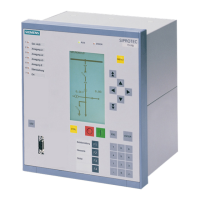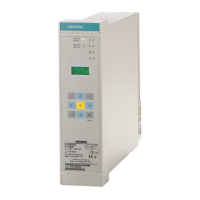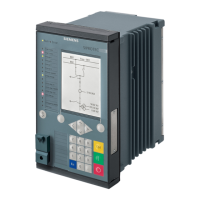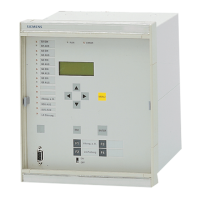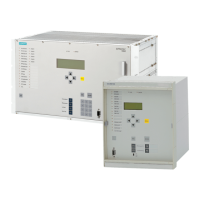Measurement During Operation
Functional Description
A series of measured values and the values derived from them are available for on-site retrieval or for data
transfer.
A precondition for a correct display of primary and percentage values is the complete and correct entry of the
rated values of the instrument transformers and the power system as well as the transformation ratio of the
current and voltage transformers in the ground paths.
Display of Measured Values
Operational measured values and metered values are determined in the background by the processor system.
They can be called up on the front of the device, read out via the operator interface using a PC with DIGSI, or
transferred to a control center via the system interface.
Table 2-10 shows a survey of the measured values of the local device. Depending on the version ordered, the
connection of the device, and the configured protection functions, only a part of the listed measured values is
available.
The displacement voltage 3V0 is calculated from the connected phase-to-ground voltages 3V
0
3V
0
= |
V
A
+ V
B
+ V
C
|.
The two devices connected via the protection interface(s) form a joint frequency value (constellation
frequency). This value is displayed as the operational measured value “Frequency”. It allows to display a
frequency even in devices in which local frequency measurement is not possible. The constellation frequency
is also used by the differential protection for synchronizing the measured values. Locally operating functions
always use the locally measured frequency.
For the thermal overload protection, the calculated overtemperatures are indicated in relation to the trip over-
temperature. Overload measured values can appear only if the overload protection was configured Enabled.
The power and operating values upon delivery are set such that power in line direction is positive. Active
components in line direction and inductive reactive components in line direction are also positive. The same
applies for the power factor cosφ.
It is occasionally desired to define the power drawn from the line (e.g. as seen from the consumer) positively.
Using parameter 1107 P,Q sign the signs for these components can be inverted.
The computation of the operational measured values is also executed during an existent system fault in inter-
vals of approx. 0.5s.
Table 2-10
Operational measured values of the local device
Measured Values Primary Secon-
dary
% referred to
Ι
A
, Ι
B
, Ι
C
Phase currents A A
Rated operational current
1)
3Ι
0
Ground current A A
Rated operational current
1)
φ(Ι
A
-I
B
), φ(Ι
B
-Ι
C
), φ(Ι
C
-
Ι
A
)
Phase angle of the phase currents
towards each other
° – –
Ι
1
, Ι
2
Positive-, negative-sequence compo-
nent of current
A A
Rated operational current
1)
V
A-B
, V
B-C
, V
C-A
Phase-to-phase voltages kV V
Rated operational voltage
2)
V
A-N
, V
B-N
, V
C-N
Phase-to-ground voltage kV V
Rated operational voltage / √3
2)
3V
0
Displacement voltage kV V
Rated operational voltage / √3
2)
φ(V
A
-V
B
), φ(V
B
-V
C
),
φ(V
C
-V
A
)
Phase angle of the phase voltages
towards each other
° – –
φ(V
A
-Ι
A
), φ(V
B
-Ι
B
),
φ(V
C
-Ι
C
)
Phase angle of the phase voltages
towards the phase currents
° – –
2.17.3
2.17.3.1
Functions
2.17 Auxiliary Functions
184 SIPROTEC 4, 7SD80, Manual
E50417-G1100-C474-A2, Edition 02.2018

